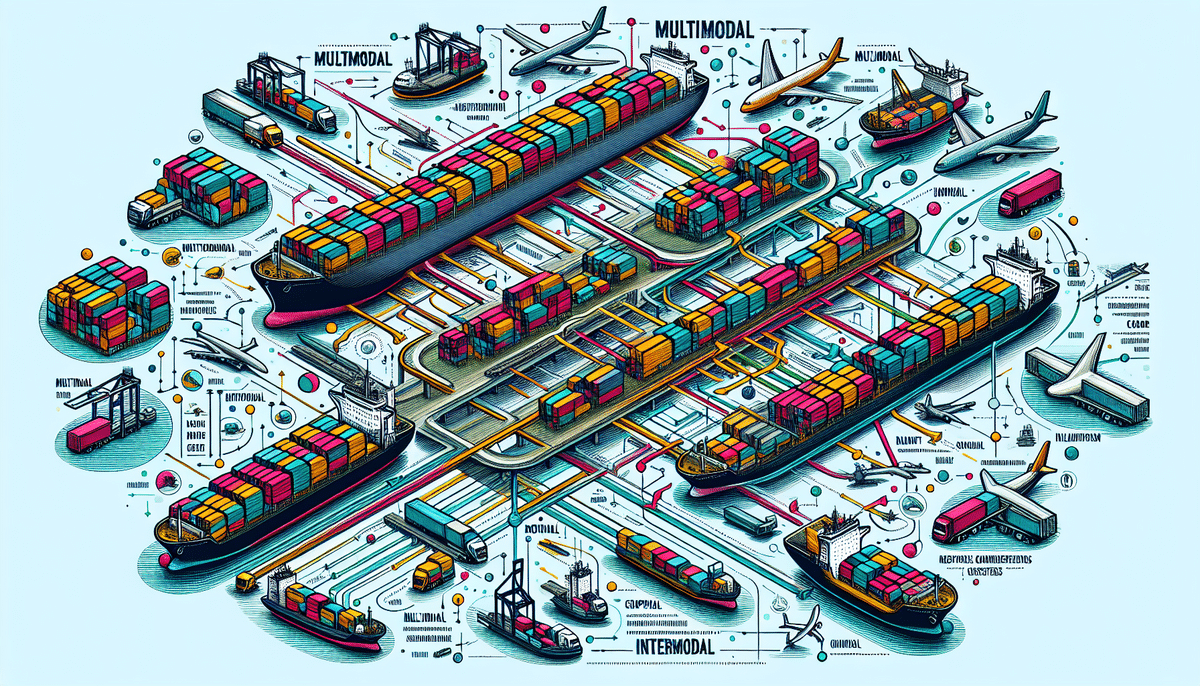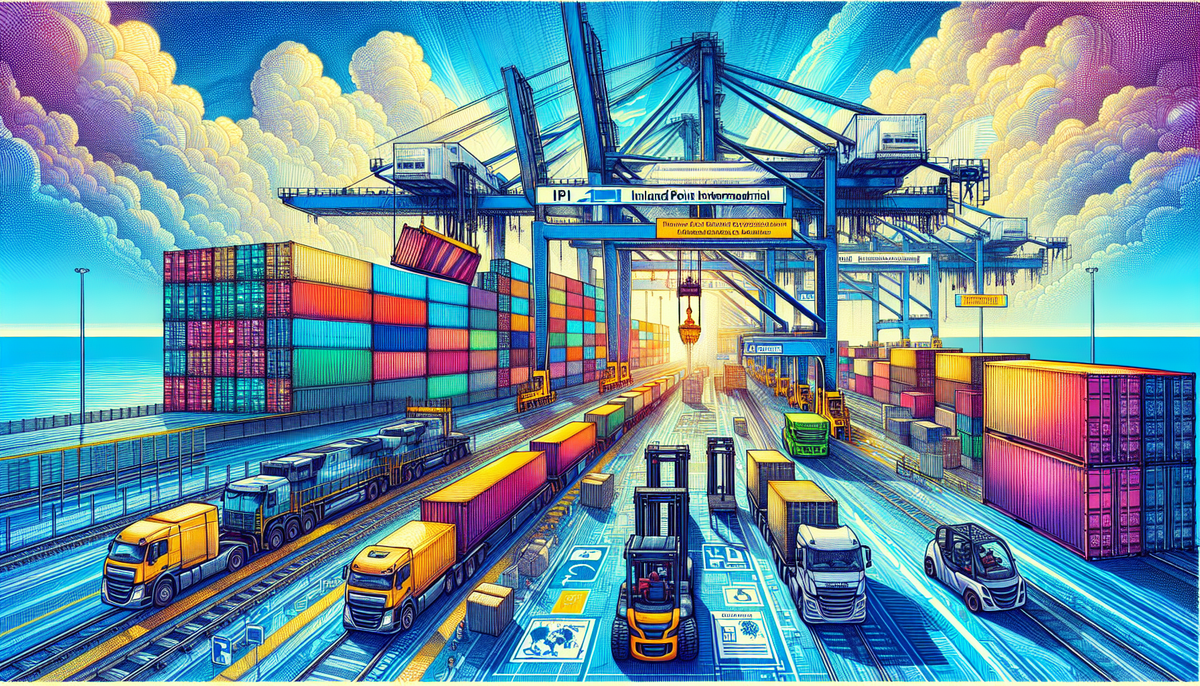Explaining Multimodal and Intermodal Shipping Methods
As businesses expand their operations globally, the demand for efficient and reliable transportation methods grows. Multimodal and intermodal shipping are pivotal in facilitating the movement of goods across diverse regions. This article delves into these shipping methods, highlighting their differences, advantages, challenges, selection criteria, and the regulatory framework that governs their use.
What are Multimodal and Intermodal Shipping Methods?
Multimodal shipping involves utilizing multiple transportation modes—such as road, air, sea, and rail—to transport goods from origin to destination. This approach may incorporate various carriers and can be applied to both domestic and international shipments. In contrast, intermodal shipping also employs multiple transportation modes but relies on a single carrier, using standardized containers that facilitate seamless transfers between modes.
Multimodal shipping offers greater flexibility in route planning, potentially leading to faster delivery times. However, it can be more complex and costly due to the coordination required among multiple carriers. On the other hand, intermodal shipping is generally more cost-effective and efficient, leveraging a single carrier and standardized containers to minimize handling and transfer times.
Advantages of Multimodal and Intermodal Shipping
- Increased Efficiency and Speed: Both shipping methods enhance the speed of moving goods by optimizing transit routes and reducing handling times.
- Reduced Transit Damage: In intermodal shipping, cargo is sealed in containers at the origin, minimizing the risk of damage and theft.
- Flexibility: Multimodal shipping allows businesses to choose the most suitable transportation modes based on specific shipment needs.
- Environmental Benefits: Utilizing multiple transportation modes can lower carbon emissions and reduce the number of trucks on the road, contributing to improved air quality.
According to the 2023 Shipping Efficiency Report, intermodal shipping can reduce transportation costs by up to 15% compared to traditional shipping methods.
Differences between Multimodal and Intermodal Shipping Methods
The key distinction lies in the number of carriers involved. Multimodal shipping engages multiple carriers across different transportation modes, whereas intermodal shipping operates under a single carrier using standardized containers. Additionally, intermodal shipping ensures that containers remain sealed from origin to destination, reducing the likelihood of cargo handling and associated risks.
Intermodal shipping is often more cost-effective due to streamlined operations and reduced handling. However, multimodal shipping provides enhanced flexibility, especially for international shipments requiring diverse transportation modes across different regions.
Examples of Multimodal and Intermodal Shipping Methods in Use Today
Intermodal shipping is frequently utilized for transporting goods between seaports using a combination of sea and rail. For example, a container might be shipped by ocean freight to a coastal rail terminal and then transported by train to an inland distribution center.
Multimodal shipping is ideal for complex logistics scenarios. For instance, goods from a manufacturing plant may be transported by truck to an airport, flown overseas, then shipped by rail to a final destination. This combination ensures timely delivery across varied transportation networks.
According to the Industry Trends 2023, businesses adopting multimodal shipping have seen a 20% increase in delivery reliability.
How to Choose Between Multimodal and Intermodal Shipping for Your Business
Selecting the appropriate shipping method depends on several factors:
- Distance and Destination: For international or long-distance shipments requiring multiple transportation modes, multimodal shipping is preferable. Intermodal shipping suits shorter, standardized routes.
- Cost Considerations: Intermodal shipping often incurs lower costs due to reduced handling and single-carrier arrangements.
- Reliability and Speed: If reliability is paramount, multimodal shipping offers multiple transit options, reducing the risk of delays. For faster delivery with fewer transfers, intermodal shipping is advantageous.
- Type of Cargo: Fragile or high-value goods benefit from the minimized handling in intermodal shipping, enhancing safety and security.
Assessing these factors in alignment with business needs ensures optimal decision-making in selecting between multimodal and intermodal shipping.
Understanding the Logistics Behind Multimodal and Intermodal Shipping
Effective logistics management is critical for both shipping methods. It encompasses the coordination of transportation, storage, and handling to ensure timely and safe delivery of goods. Multimodal shipping requires intricate coordination among various carriers and logistics providers, necessitating robust communication systems and tracking mechanisms.
Conversely, intermodal shipping benefits from standardized containers that streamline the transfer process between transportation modes. This standardization reduces the complexity of logistics operations, allowing for more predictable and manageable shipment flows.
Implementing advanced logistics software can enhance visibility and control, ensuring that shipments progress smoothly through each stage of the transportation network.
The Role of Technology in Enhancing Multimodal and Intermodal Shipping Efficiency
Technological advancements have revolutionized shipping efficiency. Real-time tracking systems enable precise monitoring of cargo, reducing uncertainties and enhancing transparency. Automation in warehouses and ports accelerates handling processes, minimizing delays.
Furthermore, the integration of predictive analytics allows logistics providers to foresee potential disruptions and address them proactively. According to a study by ShipScience Tech Innovations, predictive analytics can improve on-time delivery rates by up to 25%.
Additionally, the adoption of sustainable technologies, such as electric and hydrogen-powered vehicles, aligns shipping practices with environmental goals, reducing the carbon footprint of transportation operations.
Key Challenges Facing Multimodal and Intermodal Shipping
Despite their benefits, multimodal and intermodal shipping face several challenges:
- Increased Bureaucracy: Navigating different regulations across regions can complicate shipping processes.
- Transit Delays: Border crossings and customs procedures can extend transit times.
- Coordination Complexity: Managing multiple carriers and transportation modes increases the risk of miscommunication and errors.
- Risk of Damage and Loss: Multiple handling points in multimodal shipping heighten the potential for cargo damage or theft.
Strategies for Overcoming Common Challenges in Multimodal and Intermodal Shipping
Businesses can implement several strategies to mitigate these challenges:
- Enhanced Communication: Maintaining constant dialogue with carriers ensures real-time updates and swift resolution of issues.
- Reliable Customs Brokers: Partnering with experienced customs brokers can expedite border processes and reduce delays.
- Experienced Logistics Providers: Engaging logistics experts who can manage the end-to-end shipment process minimizes risks associated with coordination and handling.
- Investing in Technology: Utilizing advanced tracking and management systems enhances visibility and control over the shipping process.
How to Optimize Your Supply Chain Using Multimodal and Intermodal Shipping
Optimizing the supply chain through these shipping methods involves:
- Collaborating with Carriers: Developing tailored logistics solutions with carrier partners ensures that transportation aligns with specific business needs.
- Selecting Appropriate Transportation Modes: Choosing the most suitable modes based on cargo type, distance, and delivery timelines enhances efficiency.
- Ensuring Proper Insurance Coverage: Adequate insurance safeguards against potential risks during transportation.
- Leveraging Technology: Implementing systems for real-time monitoring and data analysis assists in proactive decision-making and optimization.
These strategies collectively contribute to a resilient and responsive supply chain, capable of adapting to varying market demands and logistical challenges.
Regulatory Requirements for Using Multimodal and Intermodal Shipping Methods
Compliance with regulatory frameworks is imperative for successful shipping operations. Businesses must adhere to local, state, and federal regulations, including tariffs, duties, and safety standards. Understanding the specific requirements of each transportation mode and destination country is crucial to avoid legal penalties and ensure the smooth transit of goods.
Resources such as the ShipScience Regulatory Compliance Guide provide comprehensive information on navigating the complex regulatory landscape of international shipping.
Future Trends in the World of Multimodal and Intermodal Shipping
Looking ahead, several trends are set to shape the future of shipping:
- Autonomous Vehicles: The integration of self-driving trucks and ships promises to enhance efficiency and reduce labor costs.
- Alternative Fuels: The adoption of electric and hydrogen-powered transportation methods aligns with global sustainability goals, reducing greenhouse gas emissions.
- Blockchain Technology: Implementing blockchain can enhance transparency and security in supply chain transactions.
- Internet of Things (IoT): IoT devices facilitate real-time tracking and data collection, improving logistics management.
Embracing these innovations will enable businesses to stay competitive and meet the evolving demands of the global market.
In conclusion, understanding and effectively implementing multimodal and intermodal shipping methods are essential for businesses aiming to expand their global footprint, enhance supply chain efficiency, and achieve greater customer satisfaction. By navigating the complexities of these shipping methods and leveraging technological advancements, businesses can drive competitiveness and profitability in an increasingly interconnected world.






















